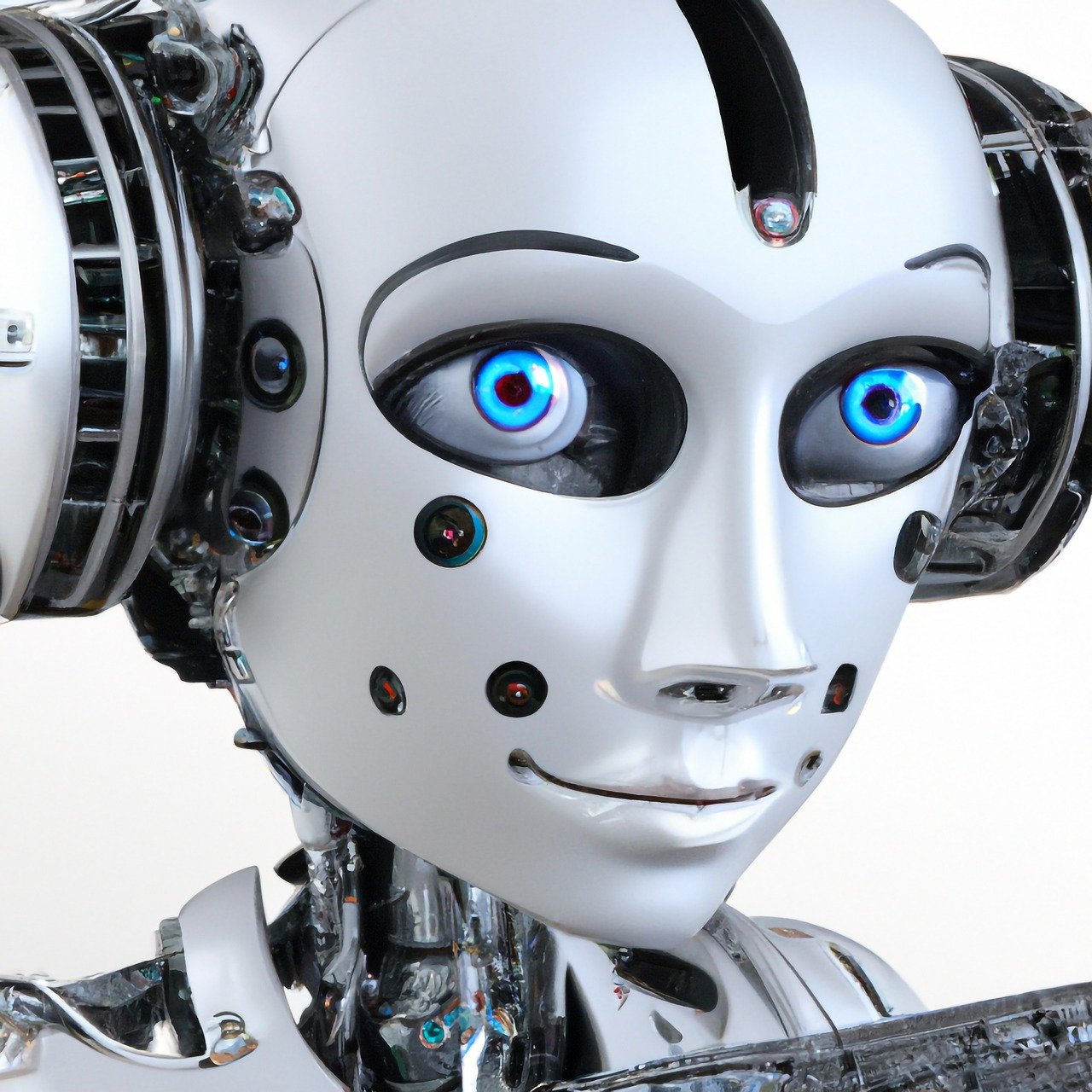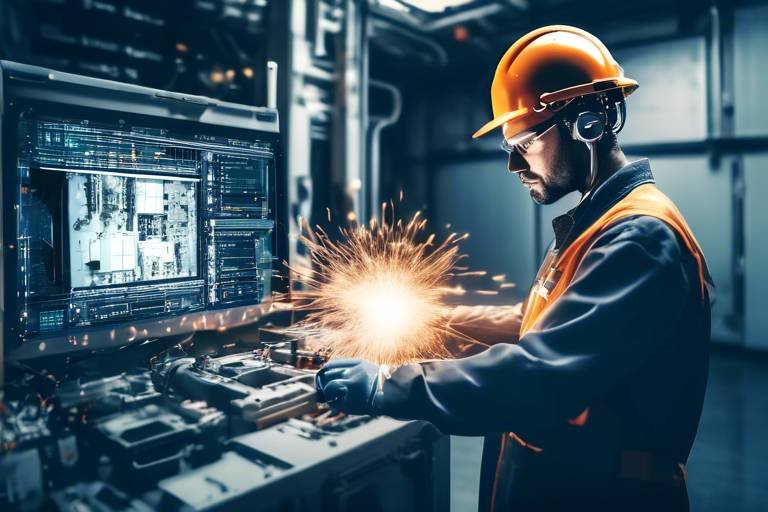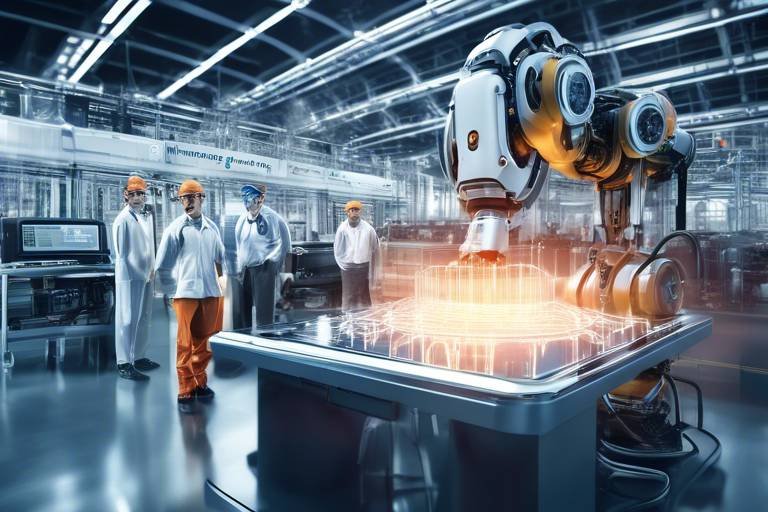AI and Predictive Maintenance: A Paradigm Shift
In today's fast-paced industrial landscape, artificial intelligence (AI) is not just a buzzword; it's a game-changer. The adoption of AI in predictive maintenance is akin to upgrading from a flip phone to a smartphone—it transforms how businesses operate, making them smarter and more efficient. Imagine having the ability to foresee equipment failures before they happen, allowing for timely interventions that save both time and money. This article delves into how AI is reshaping predictive maintenance, enhancing operational efficiency, and significantly reducing downtime across various industries.
The concept of predictive maintenance is not new; however, the integration of AI technologies has taken it to a whole new level. By leveraging advanced analytics and machine learning techniques, organizations can now analyze real-time data to make informed decisions about maintenance schedules. This shift from reactive to proactive maintenance is crucial for businesses aiming to optimize their operations and improve their bottom line.
Consider a factory where machinery operates continuously. In the past, maintenance teams would often rely on scheduled maintenance or wait for machines to break down before taking action. This approach is not only inefficient but can also lead to costly downtime. With AI-driven predictive maintenance, sensors collect data on equipment performance, and algorithms analyze this information to predict when maintenance should occur. This means that instead of waiting for a breakdown, companies can perform maintenance just in time, which leads to enhanced equipment reliability and reduced operational costs.
As we explore the transformative impact of AI on predictive maintenance, it's essential to understand the various benefits it brings to the table. From cost savings to improved efficiency, the advantages are compelling. The future of predictive maintenance is not just about keeping the lights on; it’s about harnessing the power of AI to drive innovation and operational excellence. So, buckle up as we delve deeper into this paradigm shift!

The Role of AI in Predictive Maintenance
Artificial Intelligence (AI) is not just a buzzword; it's a game changer in the realm of predictive maintenance. Imagine having the ability to foresee equipment failures before they even happen—sounds like something out of a sci-fi movie, right? But thanks to AI, this is now a reality. By leveraging real-time data analysis, AI helps organizations make informed decisions that optimize maintenance schedules and enhance equipment reliability.
So, how does AI actually work in predictive maintenance? It all starts with data. AI systems gather vast amounts of data from various sources, including sensors embedded in machinery, historical maintenance records, and operational metrics. This data is then analyzed using advanced algorithms that can identify patterns and anomalies. For instance, if a machine's temperature is consistently rising, AI can flag this as a potential issue, prompting maintenance before a catastrophic failure occurs.
Another critical aspect of AI in predictive maintenance is its ability to improve decision-making processes. With AI, organizations can move away from reactive maintenance—the old “fix it when it breaks” mentality. Instead, they can adopt a proactive approach, scheduling maintenance based on actual equipment conditions rather than arbitrary timelines. This not only enhances the lifespan of the equipment but also leads to significant cost savings.
To illustrate this further, let's consider a manufacturing facility that uses AI for predictive maintenance. By implementing an AI-driven system, the facility can:
- Monitor equipment health in real-time
- Reduce unplanned downtime by up to 30%
- Extend the lifespan of machinery by 20% or more
- Achieve a return on investment (ROI) within the first year of implementation
One of the most fascinating aspects of AI in predictive maintenance is its continuous learning capability. As more data is fed into the system, AI algorithms become increasingly adept at making accurate predictions. This means that the longer an organization utilizes AI, the more efficient its predictive maintenance strategy becomes. It’s like having a seasoned mechanic who learns from every repair they make—over time, they become incredibly skilled at diagnosing issues before they escalate.
However, it's essential to note that the integration of AI into predictive maintenance is not without its challenges. Organizations must ensure that they have the necessary infrastructure and data management systems in place to support AI technologies. This includes investing in IoT devices that can relay real-time data back to the AI system. Moreover, workforce training is crucial; employees need to be equipped with the skills to interpret AI-generated insights and take appropriate actions.
In conclusion, the role of AI in predictive maintenance is transformative. By harnessing the power of AI, organizations can not only enhance operational efficiency but also create a culture of proactive maintenance that minimizes downtime and maximizes productivity. As we move forward, it’s clear that AI will continue to play a pivotal role in shaping the future of predictive maintenance, making it an indispensable tool for businesses across various industries.
Q: What is predictive maintenance?
A: Predictive maintenance is a proactive maintenance strategy that uses data analysis tools and techniques to detect anomalies in equipment and potential defects, allowing for timely interventions before failures occur.
Q: How does AI enhance predictive maintenance?
A: AI enhances predictive maintenance by analyzing real-time data, identifying patterns, and making accurate forecasts about equipment health, leading to optimized maintenance schedules and reduced downtime.
Q: What are the key benefits of implementing AI in predictive maintenance?
A: Key benefits include reduced unplanned downtime, extended equipment lifespan, improved decision-making, and significant cost savings.
Q: What challenges might organizations face when implementing AI for predictive maintenance?
A: Challenges include data integration, technology adoption, and the need for workforce training to effectively interpret AI insights.

Benefits of Predictive Maintenance
Implementing predictive maintenance strategies is like having a crystal ball for your equipment. It allows organizations to foresee potential failures before they occur, leading to a multitude of benefits that can transform operational efficiency. One of the most significant advantages is the reduction of unplanned downtime. Imagine the chaos that ensues when machinery unexpectedly breaks down—production halts, deadlines are missed, and costs skyrocket. By utilizing AI-driven analytics, companies can monitor equipment health in real-time, enabling them to schedule maintenance activities precisely when they are needed, rather than waiting for a failure to occur.
Moreover, predictive maintenance extends the lifespan of equipment. Regularly scheduled maintenance based on actual usage and condition rather than arbitrary timelines ensures that machines are kept in optimal working order. This proactive approach not only enhances reliability but also minimizes the wear and tear that often leads to costly replacements. In fact, studies have shown that organizations that adopt predictive maintenance can increase equipment lifespan by as much as 20% to 40%.
Another key benefit is the significant cost savings associated with predictive maintenance. By reducing the frequency of emergency repairs and minimizing the need for spare parts, companies can allocate their resources more effectively. For instance, a manufacturing plant that shifts from reactive to predictive maintenance can cut its maintenance costs by up to 30%. This is not just about saving money; it’s about reallocating funds to other critical areas of the business, such as innovation or employee development.
| Benefit | Impact |
|---|---|
| Reduced Unplanned Downtime | Minimizes production disruptions and associated costs. |
| Extended Equipment Lifespan | Decreases the frequency of replacements and repairs. |
| Cost Savings | Reduces overall maintenance costs by optimizing resource allocation. |
In addition to these benefits, predictive maintenance also promotes a culture of continuous improvement within organizations. By analyzing data and learning from past maintenance activities, companies can refine their processes and improve their operational strategies. This iterative approach not only enhances performance but also fosters a more engaged workforce, as employees see the direct impact of their efforts on the organization’s success.
As industries increasingly recognize the importance of predictive maintenance, it’s becoming a crucial component of modern operational strategies. The integration of AI technologies with maintenance practices is not just a trend; it's a fundamental shift that promises to reshape how businesses operate in the future. So, if you’re still relying on reactive maintenance, it’s time to consider making the switch. The advantages are clear, and the potential for growth and innovation is immense.
- What is predictive maintenance? Predictive maintenance is a proactive approach that uses data analysis and AI to predict equipment failures before they occur, allowing for timely maintenance interventions.
- How does AI enhance predictive maintenance? AI enhances predictive maintenance by analyzing vast amounts of data in real-time, identifying patterns, and providing insights that help in decision-making and scheduling maintenance.
- What industries benefit from predictive maintenance? Industries such as manufacturing, transportation, energy, and healthcare have all seen significant benefits from implementing predictive maintenance strategies.
- Is predictive maintenance cost-effective? Yes, predictive maintenance can lead to substantial cost savings by reducing unplanned downtime, minimizing emergency repairs, and extending equipment lifespan.

Cost Savings and Efficiency
When it comes to running a successful business, one of the most critical aspects is ensuring that every dollar spent contributes to the bottom line. This is where predictive maintenance shines. By leveraging advanced analytics and artificial intelligence, organizations can significantly reduce costs while enhancing operational efficiency. Imagine a scenario where machinery operates at peak performance without unexpected breakdowns—sounds like a dream, right? Well, with predictive maintenance, that dream is becoming a reality.
Predictive maintenance focuses on anticipating equipment failures before they occur, allowing businesses to schedule timely maintenance. This proactive approach not only minimizes emergency repairs but also extends the lifespan of equipment. Instead of waiting for a machine to fail, organizations can replace parts or perform maintenance based on actual data and predictions. This shift from reactive to proactive maintenance results in substantial cost savings and boosts overall efficiency.
Consider the following benefits of implementing predictive maintenance:
- Reduced Unplanned Downtime: By predicting failures, companies can avoid the costly interruptions that come with unplanned equipment breakdowns.
- Maximized Equipment Efficiency: Regular maintenance ensures that machinery operates at optimal levels, leading to higher productivity.
- Resource Allocation: With fewer emergency repairs, organizations can allocate their resources more effectively, focusing on strategic growth rather than constant troubleshooting.
To illustrate the financial impact, let’s look at a hypothetical example. A manufacturing company that implements predictive maintenance might reduce its annual maintenance costs from $500,000 to $300,000. This $200,000 savings can then be reinvested into other areas of the business, such as innovation and employee training. The ripple effect of these savings can be profound, leading to increased employee morale and driving the company towards greater success.
Moreover, the efficiency gained from predictive maintenance can lead to a competitive advantage. Businesses that adopt these strategies can respond to market demands more swiftly, improving their service delivery and customer satisfaction. In a world where customers expect quick turnaround times, being able to operate smoothly without interruptions can set a company apart from its competitors.
In summary, the integration of predictive maintenance not only enhances operational efficiency but also leads to significant cost savings. By investing in this innovative approach, organizations can create a more resilient operational framework, ultimately paving the way for long-term success. The shift toward predictive maintenance is not just a trend; it’s a strategic move that can redefine how businesses operate in the modern landscape.
- What is predictive maintenance? Predictive maintenance is a proactive approach that uses data analysis tools and techniques to detect anomalies in equipment operation and potential defects.
- How does AI contribute to predictive maintenance? AI enhances predictive maintenance by analyzing vast amounts of data in real-time, allowing for more accurate predictions about equipment failures.
- What are the main benefits of implementing predictive maintenance? The main benefits include reduced downtime, extended equipment life, improved resource allocation, and significant cost savings.
- What challenges might a company face when implementing predictive maintenance? Challenges can include data integration issues, the need for technology adoption, and workforce training.

Case Studies in Cost Reduction
In the ever-evolving landscape of industry, predictive maintenance has emerged as a game-changer, and several organizations have successfully harnessed its power to achieve remarkable cost reductions. Let’s take a look at a few compelling case studies that highlight the transformative impact of AI-driven predictive maintenance.
One notable example is a major manufacturing firm that implemented a predictive maintenance strategy across its production lines. By utilizing machine learning algorithms to analyze historical data and real-time sensor inputs, the company was able to predict equipment failures before they occurred. This proactive approach not only helped them avoid costly emergency repairs but also reduced their maintenance costs by an impressive 30%. As a result, the company saw a significant uptick in production efficiency, which translated into higher output without the need for additional resources.
Another compelling case is that of a leading airline that adopted predictive maintenance for its fleet of aircraft. By integrating IoT devices and advanced analytics, the airline could monitor engine performance continuously. This approach led to the identification of potential issues well in advance, allowing for scheduled maintenance during routine checks instead of unexpected groundings. The outcome? A staggering 25% reduction in maintenance costs and improved flight schedules, ensuring that planes spent less time on the ground and more in the air.
Furthermore, a utility company focused on its aging infrastructure implemented predictive maintenance techniques to monitor its power generation equipment. By leveraging AI to analyze data from various sensors, the company could forecast when components were likely to fail. This foresight enabled them to replace parts proactively, which resulted in a 40% decrease in unplanned outages. The financial implications were significant, as they saved millions in lost revenue and repair costs.
These case studies exemplify the profound impact of predictive maintenance on cost reduction and operational efficiency. By leveraging advanced analytics and real-time data, organizations across various sectors are not just surviving but thriving in a competitive marketplace. The key takeaway here is that investing in predictive maintenance is not merely a cost but a strategic move that can yield substantial returns over time.
| Organization | Industry | Cost Reduction (%) | Key Benefits |
|---|---|---|---|
| Major Manufacturing Firm | Manufacturing | 30% | Increased production efficiency |
| Leading Airline | Aviation | 25% | Improved flight schedules |
| Utility Company | Utilities | 40% | Reduced unplanned outages |
As we can see, these organizations have not only achieved remarkable cost savings but have also enhanced their operational resilience, paving the way for future success. The integration of AI and predictive maintenance is clearly a smart investment for any organization aiming to stay ahead in today's fast-paced environment.
- What is predictive maintenance?
Predictive maintenance is a proactive maintenance strategy that uses data analysis and machine learning to predict equipment failures before they occur, allowing for timely interventions. - How does AI enhance predictive maintenance?
AI enhances predictive maintenance by analyzing vast amounts of data in real-time, improving the accuracy of predictions and enabling organizations to optimize their maintenance schedules. - What industries benefit from predictive maintenance?
Industries such as manufacturing, aviation, utilities, and transportation can significantly benefit from predictive maintenance, leading to cost savings and improved operational efficiency. - What are the challenges of implementing predictive maintenance?
Challenges include data integration, technology adoption, and the need for workforce training, which require careful planning and execution.

Long-Term Financial Impact
When we talk about the of predictive maintenance, it's essential to recognize that the benefits extend far beyond immediate cost savings. Implementing a robust predictive maintenance strategy can transform how organizations manage their assets and resources, leading to a ripple effect of positive financial outcomes. For instance, companies that adopt these strategies often see a significant reduction in capital expenditures over time, as they can anticipate and address potential equipment failures before they escalate into costly repairs.
Consider a manufacturing plant that traditionally relied on reactive maintenance. Each unplanned breakdown not only halts production but also incurs expensive emergency repair costs and potential revenue losses. By shifting to predictive maintenance, this plant can leverage data analytics to foresee when a machine is likely to fail. This foresight allows for scheduled repairs during non-peak hours, minimizing disruptions and maintaining productivity. The financial implication? The plant can save thousands of dollars annually in reduced downtime and repair costs.
Moreover, the integration of predictive maintenance fosters improved asset management. Organizations can optimize their inventory of spare parts, ensuring that they have the right components on hand without overstocking. This balance leads to a more efficient use of capital, freeing up funds that can be reinvested in other areas of the business. As shown in the table below, the correlation between predictive maintenance and financial performance is evident:
| Metric | Before Predictive Maintenance | After Predictive Maintenance |
|---|---|---|
| Annual Downtime Cost | $500,000 | $200,000 |
| Emergency Repair Costs | $300,000 | $50,000 |
| Inventory Holding Costs | $150,000 | $100,000 |
The table clearly illustrates the dramatic reductions in costs associated with predictive maintenance. As organizations continue to reap these financial benefits, they also cultivate a culture of continuous improvement and innovation. Employees become more engaged as they see the direct impact of their work on the company's bottom line, leading to enhanced morale and productivity.
In conclusion, the long-term financial impact of predictive maintenance is not merely about saving money; it's about creating a sustainable operational model that supports growth and resilience. As industries evolve and technology advances, those who embrace predictive maintenance will find themselves at a distinct advantage, equipped to navigate the complexities of modern business with confidence.
- What is predictive maintenance? Predictive maintenance is a proactive approach that uses data analysis tools and techniques to identify the condition of equipment and predict when maintenance should be performed.
- How does AI enhance predictive maintenance? AI enhances predictive maintenance by analyzing vast amounts of data in real-time, identifying patterns, and providing actionable insights that help in decision-making.
- What are the key benefits of implementing predictive maintenance? Key benefits include reduced downtime, lower maintenance costs, improved equipment lifespan, and enhanced operational efficiency.
- What challenges might organizations face when implementing predictive maintenance? Challenges include data integration, technology adoption, workforce training, and the need for a cultural shift within the organization.

Challenges in Implementation
While the potential of predictive maintenance powered by artificial intelligence (AI) is immense, the journey towards its implementation is not without hurdles. Organizations often encounter several challenges that can impede their progress. One of the most significant obstacles is data integration. Many companies have disparate systems and data sources, making it difficult to gather and analyze the necessary information effectively. Without a unified data framework, achieving accurate predictions becomes a daunting task.
Another challenge is technology adoption. Implementing new technologies requires a shift in mindset and culture within an organization. Employees may resist changes, especially if they feel threatened by automation or are unsure about how to utilize new tools effectively. This resistance can slow down the adoption process and lead to underutilization of the predictive maintenance systems in place.
Moreover, workforce training is crucial yet often overlooked. Even the most advanced AI systems are only as good as the people operating them. Organizations must invest in comprehensive training programs to ensure that their staff is equipped with the necessary skills to interpret data, make informed decisions, and operate new technologies confidently. Without proper training, the benefits of predictive maintenance can be significantly diminished.
To illustrate these challenges, consider the following table that summarizes key implementation obstacles:
| Challenge | Description |
|---|---|
| Data Integration | Difficulty in merging data from various sources, leading to incomplete analysis. |
| Technology Adoption | Resistance from employees to embrace new technologies and processes. |
| Workforce Training | Lack of adequate training programs for staff to utilize predictive maintenance tools effectively. |
In addition to these challenges, organizations must also navigate the complexities of cost management. Implementing predictive maintenance systems can require a significant upfront investment in technology and training. Companies need to weigh these costs against the long-term benefits to justify the transition. This often leads to a critical question: Is the initial investment worth the potential savings and efficiency gains in the long run?
Ultimately, overcoming these challenges requires a strategic approach. Companies must be prepared to invest time, resources, and effort to address the issues of data integration, technology adoption, and workforce training. By doing so, they can harness the full potential of predictive maintenance and reap the benefits of enhanced operational efficiency and reduced downtime.
- What is predictive maintenance? Predictive maintenance is a proactive approach to maintenance that uses data analysis and AI to predict equipment failures before they occur.
- How does AI improve predictive maintenance? AI enhances predictive maintenance by providing real-time data analysis, enabling better decision-making, and optimizing maintenance schedules.
- What are the main benefits of predictive maintenance? Key benefits include reduced unplanned downtime, extended equipment lifespan, and significant cost savings.
- What challenges do organizations face when implementing predictive maintenance? Common challenges include data integration, technology adoption, and workforce training.

Technological Advancements Driving Change
The landscape of predictive maintenance is undergoing a radical transformation, primarily fueled by recent technological advancements in artificial intelligence (AI), the Internet of Things (IoT), and big data analytics. These innovations are not merely incremental improvements; they represent a paradigm shift in how organizations approach maintenance strategies. Imagine a world where machines can predict their own failures before they happen, allowing companies to take proactive measures instead of reactive ones. This is not science fiction; it’s the reality we are stepping into.
At the heart of this transformation is the integration of AI algorithms that analyze vast amounts of data in real-time. These algorithms are designed to learn from historical data, enabling them to identify patterns and anomalies that human analysts might overlook. For instance, a manufacturing plant equipped with AI can monitor equipment conditions continuously, alerting operators when specific thresholds are reached. This capability allows companies to shift from a traditional maintenance schedule to a more dynamic, need-based approach.
Moreover, the integration of IoT devices has taken predictive maintenance to the next level. With sensors embedded in machinery, organizations can collect data on various parameters such as temperature, vibration, and pressure. This continuous stream of information facilitates real-time analysis, allowing for timely interventions. For example, if a sensor detects an unusual vibration in a motor, the system can immediately alert maintenance personnel, potentially preventing a costly breakdown. The synergy between AI and IoT creates a feedback loop that continuously improves the accuracy of predictions.
To illustrate the impact of these advancements, consider the following table that highlights key technologies driving change in predictive maintenance:
| Technology | Impact on Predictive Maintenance |
|---|---|
| Artificial Intelligence | Enhances data analysis and forecasting accuracy. |
| Internet of Things (IoT) | Enables real-time monitoring and data collection. |
| Big Data Analytics | Processes large datasets for deeper insights and trends. |
| Machine Learning | Improves predictive models through continuous learning. |
As we delve deeper into the future, the role of big data analytics cannot be overstated. Organizations are now equipped with tools that can not only analyze data but also visualize it in meaningful ways. This means that decision-makers can easily interpret complex datasets and make informed choices that enhance operational efficiency. The ability to predict failures before they occur is akin to having a crystal ball—one that provides insights into the health of equipment and the overall operational landscape.
In conclusion, the technological advancements driving change in predictive maintenance are reshaping industries by enhancing the way we monitor and maintain equipment. As organizations continue to embrace these innovations, the potential for improved operational resilience and efficiency becomes not just a possibility, but a reality. The future of predictive maintenance is bright, and those who adapt to these changes will undoubtedly reap the rewards.
- What is predictive maintenance? Predictive maintenance is a strategy that uses data analysis tools and techniques to predict when equipment will fail, allowing for timely maintenance interventions.
- How does AI improve predictive maintenance? AI enhances predictive maintenance by analyzing large datasets to identify patterns and anomalies, enabling more accurate predictions of equipment failures.
- What role do IoT devices play in predictive maintenance? IoT devices collect real-time data from machinery, facilitating continuous monitoring and timely alerts for maintenance needs.
- What are the long-term benefits of implementing predictive maintenance? Long-term benefits include reduced downtime, extended equipment lifespan, and significant cost savings.

AI Algorithms and Machine Learning
The landscape of predictive maintenance is undergoing a dramatic transformation, thanks to the integration of AI algorithms and machine learning technologies. These advanced methodologies enable organizations to move from reactive maintenance approaches to a more proactive stance. But what exactly does this mean? Imagine having a crystal ball that not only predicts when a machine might fail but also suggests the best time to perform maintenance. This is the power of AI in predictive maintenance!
At the heart of this revolution are sophisticated algorithms that analyze vast amounts of data generated by equipment. These algorithms can identify patterns and trends that human analysts might overlook. For instance, by examining historical performance data, AI can discern subtle changes in a machine's behavior that may indicate an impending failure. The result? Companies can intervene before a breakdown occurs, saving both time and money.
One of the key advantages of machine learning is its ability to improve over time. As more data is fed into the system, the algorithms become increasingly accurate in their predictions. This self-improving capability is akin to a fine wine maturing in a cellar; the longer it sits, the better it gets. Organizations can leverage this feature to refine their maintenance schedules continuously, ensuring that they are always one step ahead of potential issues.
However, the implementation of these AI algorithms is not without its challenges. Companies must ensure they have access to high-quality data and the necessary infrastructure to support advanced analytics. This can involve significant investment in technology and training. But the payoff can be substantial. For example, a manufacturing plant that integrates machine learning into its maintenance strategy might see a reduction in downtime by as much as 30%.
To illustrate the impact of AI algorithms in predictive maintenance, consider the following table that outlines the benefits compared to traditional maintenance methods:
| Aspect | Traditional Maintenance | Predictive Maintenance with AI |
|---|---|---|
| Downtime | High, due to unexpected failures | Reduced, with timely interventions |
| Maintenance Costs | Higher, with frequent emergency repairs | Lower, with optimized maintenance schedules |
| Equipment Lifespan | Shorter, due to wear and tear | Longer, with regular monitoring and care |
| Data Utilization | Minimal, often reactive | Maximized, with proactive insights |
In conclusion, AI algorithms and machine learning are not just buzzwords; they represent a paradigm shift in how organizations approach maintenance. By harnessing the power of these technologies, businesses can achieve unprecedented levels of efficiency and reliability. So, are you ready to embrace the future of maintenance?
- What is predictive maintenance? Predictive maintenance is a proactive maintenance strategy that uses data analysis to predict when equipment will fail, allowing for timely interventions.
- How do AI algorithms improve predictive maintenance? AI algorithms analyze historical data to identify patterns and anomalies, enabling more accurate predictions of equipment failures.
- What are the challenges of implementing AI in maintenance? Challenges include data quality, technology integration, and the need for workforce training.
- Can predictive maintenance save costs? Yes, by reducing unplanned downtime and emergency repairs, predictive maintenance can lead to significant cost savings.

Integration with IoT Devices
The integration of predictive maintenance with Internet of Things (IoT) devices is like adding a turbocharger to an already powerful engine. Imagine a world where your machines can communicate their health status in real-time, alerting you to potential issues before they escalate into costly breakdowns. This is the reality that IoT brings to predictive maintenance, transforming how industries operate.
IoT devices are equipped with sensors that continuously monitor various parameters such as temperature, vibration, and pressure. These devices collect a wealth of data, which is then transmitted to a centralized system for analysis. By leveraging advanced analytics and AI algorithms, organizations can gain invaluable insights into equipment performance. For instance, if a machine's vibration levels start to rise beyond normal thresholds, the system can predict a potential failure and prompt maintenance before a breakdown occurs.
Moreover, integrating IoT devices allows for a more proactive approach to maintenance. Instead of following a rigid maintenance schedule, organizations can shift to a model where maintenance is performed based on actual equipment condition. This not only reduces unnecessary maintenance tasks but also optimizes the use of resources. For example, a manufacturing plant can avoid shutting down a production line for routine checks and instead focus on addressing only the machines that require attention.
To illustrate the impact of IoT integration in predictive maintenance, consider the following table:
| IoT Device | Monitoring Capability | Predictive Maintenance Benefit |
|---|---|---|
| Vibration Sensors | Track vibrations in machinery | Detect imbalances or misalignments |
| Temperature Sensors | Monitor operating temperatures | Prevent overheating and failures |
| Pressure Sensors | Measure pressure levels in systems | Identify leaks or blockages |
This table highlights just a few examples of how different IoT devices contribute to the predictive maintenance landscape. By utilizing these technologies, organizations can not only enhance operational efficiency but also create a safer working environment. Imagine the peace of mind knowing that your equipment is constantly being monitored, allowing you to focus on what truly matters—growing your business.
In conclusion, the integration of IoT devices into predictive maintenance strategies is a game-changer. It empowers organizations to make data-driven decisions, reduces the risk of unexpected failures, and ultimately leads to substantial cost savings. As we move forward, the synergy between IoT and predictive maintenance will undoubtedly pave the way for more innovative solutions and enhanced operational resilience.
- What is predictive maintenance? Predictive maintenance is a proactive maintenance strategy that uses data analysis tools and techniques to detect anomalies in equipment operation and potential failures.
- How do IoT devices enhance predictive maintenance? IoT devices collect real-time data from equipment, allowing for continuous monitoring and timely interventions to prevent failures.
- What are the benefits of integrating IoT with predictive maintenance? Benefits include reduced downtime, optimized maintenance schedules, extended equipment lifespan, and significant cost savings.

Future Trends in Predictive Maintenance
As we look ahead, the landscape of predictive maintenance is evolving at an unprecedented pace, driven by the relentless advancement of technology. The integration of artificial intelligence (AI), big data analytics, and the Internet of Things (IoT) is not just a trend; it’s a revolution. Imagine a future where machines not only report their health status but also predict potential failures before they occur, allowing businesses to take proactive measures. This shift is not merely about efficiency; it's about creating a resilient operational framework that can adapt to unforeseen challenges.
One of the most exciting trends is the increasing use of predictive analytics powered by AI algorithms. These sophisticated models analyze vast amounts of data to identify patterns and anomalies that human analysts might overlook. For instance, a manufacturing plant could leverage these insights to predict when a critical machine is likely to fail, enabling maintenance teams to intervene before a costly breakdown occurs. This proactive approach not only saves money but also enhances overall productivity.
Moreover, the integration of IoT devices plays a crucial role in the future of predictive maintenance. With sensors embedded in machinery, real-time data can be collected and analyzed continuously. This constant stream of information allows businesses to monitor equipment health and performance metrics in real-time, leading to more informed decision-making. Imagine being able to foresee a problem before it disrupts production—this is the power of IoT in predictive maintenance.
Another trend to watch is the rise of automated maintenance systems. As AI continues to improve, we can expect to see more autonomous systems capable of performing maintenance tasks with little to no human intervention. This not only reduces labor costs but also minimizes the risk of human error. For example, a mining company could deploy drones equipped with sensors to inspect equipment in hard-to-reach areas, ensuring that maintenance is performed efficiently and safely.
In addition to these technological advancements, organizations are increasingly focusing on data security and privacy. With the rise of connected devices, the potential for cyber threats also increases. Companies will need to invest in robust cybersecurity measures to protect sensitive data and maintain operational integrity. This focus on security will be essential for building trust in predictive maintenance systems.
Finally, as predictive maintenance becomes more mainstream, we are likely to see a shift in workforce dynamics. Training and upskilling employees to work alongside these advanced technologies will be crucial. Organizations will need to foster a culture of continuous learning, enabling their workforce to adapt to new tools and methodologies. This is not just about technology; it's about empowering people to harness the full potential of predictive maintenance.
In conclusion, the future of predictive maintenance is bright, filled with opportunities for innovation and efficiency. As we embrace these trends, businesses will not only improve their bottom line but also enhance their operational resilience, preparing them for whatever challenges lie ahead.
- What is predictive maintenance? Predictive maintenance is a proactive maintenance strategy that uses data analysis tools and techniques to detect anomalies in equipment operation and potential defects, allowing maintenance to be performed just in time.
- How does AI enhance predictive maintenance? AI enhances predictive maintenance by analyzing large datasets to identify patterns and predict equipment failures before they occur, allowing for timely interventions.
- What role do IoT devices play in predictive maintenance? IoT devices collect real-time data from machinery, enabling continuous monitoring and analysis, which helps in making informed maintenance decisions.
- What are the benefits of implementing predictive maintenance? Benefits include reduced downtime, extended equipment lifespan, lower maintenance costs, and improved operational efficiency.
- What challenges might organizations face in adopting predictive maintenance? Challenges include data integration, technology adoption, workforce training, and ensuring data security.
Frequently Asked Questions
- What is predictive maintenance?
Predictive maintenance is a proactive approach to equipment maintenance that uses data analysis and AI technologies to predict when maintenance should be performed. This helps in preventing unexpected equipment failures and reduces downtime, ultimately saving costs and improving operational efficiency.
- How does AI enhance predictive maintenance?
AI enhances predictive maintenance by analyzing vast amounts of data in real-time, identifying patterns, and making accurate predictions about equipment health. This leads to better decision-making, optimized maintenance schedules, and increased reliability of machinery.
- What are the main benefits of implementing predictive maintenance?
The main benefits include reduced unplanned downtime, extended equipment lifespan, significant cost savings, and improved resource allocation. By anticipating maintenance needs, organizations can maintain productivity and avoid costly emergency repairs.
- What challenges might organizations face when implementing predictive maintenance?
Organizations may encounter challenges such as integrating new technologies, adapting existing systems, training the workforce, and managing the vast amounts of data generated. Careful planning and execution are crucial to overcome these hurdles.
- How do IoT devices contribute to predictive maintenance?
IoT devices facilitate continuous monitoring and data collection from equipment. This real-time data enables organizations to analyze equipment performance, predict failures, and implement timely maintenance interventions, thus optimizing their maintenance strategies.
- What are some future trends in predictive maintenance?
Future trends may include greater integration of AI and machine learning, more advanced analytics, and increased automation. These advancements will likely lead to innovative solutions that enhance operational resilience and improve maintenance practices across industries.



















